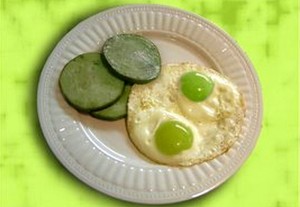
Eat Green!
Tweet
There are many ways to eat green… and I’m not talking about getting more green food in your diet (though, that’s not a bad idea either). I’m talking about eating environmentally… eating things that will help keep our planet green and your family healthy.
Let’s start with Organics. If you haven’t already heard… pesticides, fungicides and other chemical plant and soil treatments are BAD for you. Very BAD… and very bad for the environment, the land, the animals, global stability, you name it. So… what’s an eater to do? Is it realistic to purchase all your food in their organic form? No, probably not for the average American family. Organic produce is still priced higher than regular produce and finding all your dietary needs in organic forms is not easy for everyone.
What you can do however, is protect yourself — and help the environment at the same time — by staying away from the DIRTY DOZEN, as the Environmental Working Group likes to call them. I get the EWG’s regular email newsletters and they are quite helpful. I suggest you check out their site and consider signing up as well.
The DIRTY DOZEN are the 12 most pesticide-contaminated fruits and vegetables out there. If you can only afford to spend some of your weekly food budget on organics, this is the list to buy:
- Peaches
- Apples
- Bell Peppers
- Celery
- Nectarines
- Strawberries
- Cherries
- Kale
- Lettuce
- Grapes (Imported)
- Carrot
- Pear
These babies are infested with pesticides. If you do buy these in their non-organic form… make sure you use a vegetable wash to clean them thoroughly before eating them… especially if you have children.
On the flip-side, these are the CLEAN FIFTEEN — the fruits and vegetables that have the lowest levels of pesticides. Of course you still want to wash them before eating them (even those you peel the skin or remove the rind from), but you can feel “okay” about buying these items in their non-organic form:
- Onion
- Avocado
- Sweet Corn
- Pineapple
- Mango
- Asparagus
- Sweet Peas
- Kiwi
- Cabbage
- Eggplant
- Papaya
- Watermelon
- Broccoli
- Tomato
- Sweet Potato
Curious about other ways to eat green? Then visit the Eating Green website… where you can calculate how “green you eat” by inputting the amount of beef, chicken, pork, dairy and eggs you consume each week and in turn, you will get a calculation that provides you with the environmental burden of the animal products you eat in one year.
I don’t eat beef or pork and very little chicken (only once a week)… but I do have dairy daily and eggs and cheese at least 3 times a week. Sad enough, if I continue with my current eating habits, this is my burden:
- 0.2 acres of grain and grass needed for animal feed each year
- 10.6 pounds of fertilizer used to grow animal feed
- 0.1 pounds of pesticides used to grow animal feed
- 1347 pounds of manure created (think green house gasses) by the animals I eat
And this is just me… not my entire family. You can also score your diet by inputting everything you eat and tour the food supply for information and facts on all the steps that happen to get that meat to your table. Pretty disconcerting.
One way to help? Keep it local. Buy as many products as you can from local businesses and farmers. Now that the warmer months are coming, more and more farm stands and CSAs will be offering locally grown produce — many times pesticide free — to our local communities. Indulge… you will be happy with — not on the taste of produce that is grown close to home — but also by the impact your purchases make on the environment. It’s St. Patrick’s Day… GO GREEN already!

